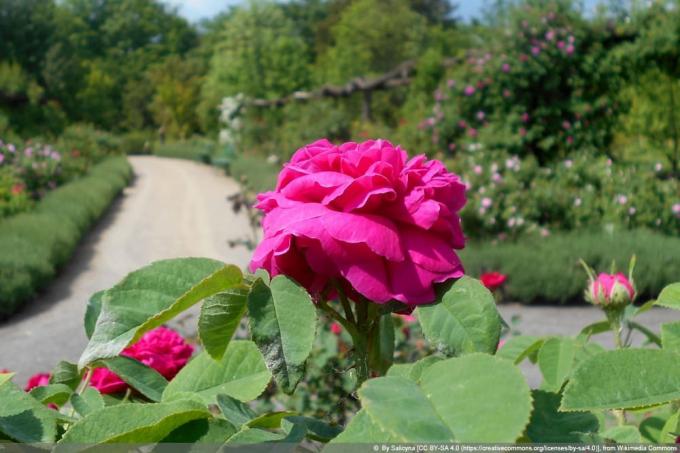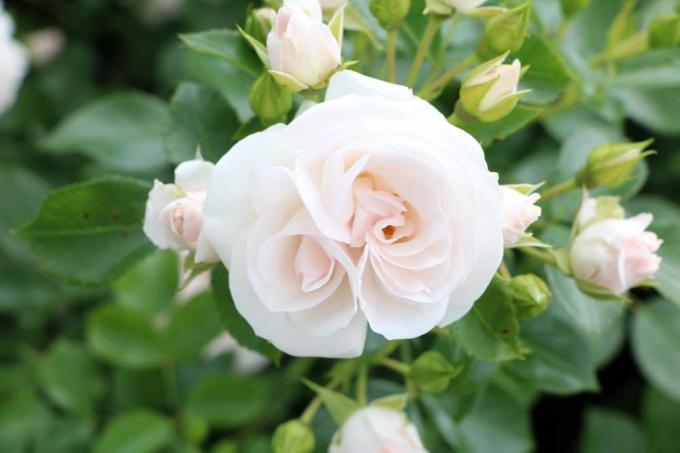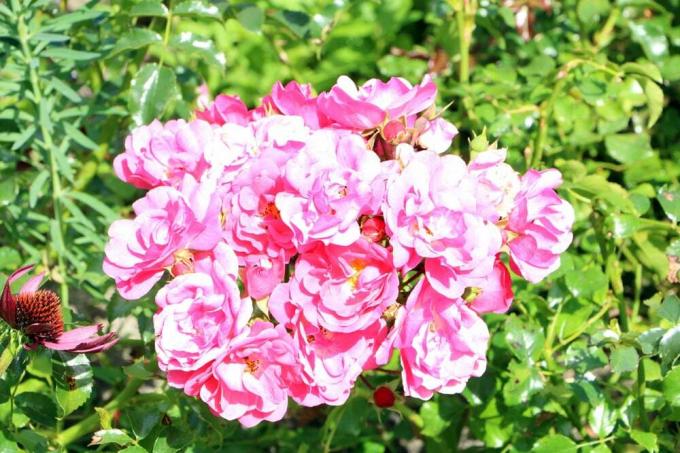

Table of contents
- Characteristics
- Location
- Floor
- planting
- care instructions
- Pour
- Fertilize
- Cut
- hibernate
- transplant
- propagation
- About cuttings
- By sowing
- Diseases
- pests
Once standard in traditional cottage gardens, the moss rose fell into oblivion over time and could only be admired as an illustration on old porcelain. It is now being rediscovered and is finding more and more fans. It grows as a large shrub with a height of up to 180 cm. Mossrose blooms once and develops colorful, medium-sized, double flowers.
Characteristics
- Genus: mutation of centifolia
- Botanical name: Rosa centifolia var. mucosa
- German name: Moosrose, Moosröschen
- Growth: spreading, overhanging shoots
- Growth height: 150-180 cm
- Leaves: grey-green, slightly glossy
- Flower: medium-sized, filled, different shades of pink
- Flowering period: June to August
- Fragrance: intense with a slightly spicy note
- Lime tolerance: Lime tolerant
- Use: cottage and natural gardens, as a solitary or background plant
Location
Rosa centifolia var. It is not without reason that Muscosa is one of the oldest rose varieties, they are very robust and only slightly susceptible to diseases. The right location is of particular importance. It should be airy and sunny with several hours of sun a day. A place in the blazing midday sun should be avoided. An airy location is important so that the foliage can always dry off quickly. Consequently, space under larger deciduous trees is rather unsuitable. A planting site that is not protected from heavy rain increases the susceptibility to fungal diseases such as black spot and powdery mildew. The right location can also make maintenance much easier.
Floor
When it comes to the soil conditions, moss roses should not be planted where roses but also apples, pears, plums or cherries have stood in previous years. Otherwise, soil fatigue may occur. Even the best care is useless. The plants grow more slowly, shoot weakly and the formation of flowers is severely reduced. The main cause should be pathogens or be root-damaging bacteria. Roses do not thrive there even after more than ten years.
- Mixing rose-tired soil with fresh soil is not sufficient
- Complete, large-scale replacement required
- To a depth of at least 80 cm
- Find a location with unpolluted soil
- Make contaminated soil fit for the long term
- Add compost and algae lime
- The soil is thus supplied with trace elements
- Then a green manure z. B. sow with yellow mustard and marigolds
- Provides soil with humus and repels nematodes

The soil at the new location should be rich in nutrients and humus, moderately dry to moderately moist and neutral to slightly acidic. Gravelly to clayey soils are very good. Heavier ones are improved with sand and light ones with a good portion of compost or well-seasoned manure.
planting
Before planting, careful preparation of the subsoil is required. It is loosened up to a depth of about 50 cm and root weeds such as goutweed and couch grass and other root residues are removed from it.
- Then dig the planting hole
- About twice as deep and wide as the pad
- Because of taproots, more deep than wide
- Mix the excavated soil with well-rotted compost or humus
- Soak bales of bare-root moss rosettes for 12 to 24 hours
- Container goods until no more air bubbles rise
- In the next step, shorten the rose shoots to 20 cm
- Also trim the roots
- Loosen root ball of container plants by gently pulling
Then the moss rose can be planted and watered. Planting time for a bare root Rosa centifolia var. Muscosa is in the fall and spring, but preferably in the fall. Container plants can be planted all year round as long as the soil is frost-free.
care instructions
This moss rose is the perfect solitary plant, but it also comes into its own in a border. Due to its compact growth and a height of approx. 150 cm, it is even suitable as a hedge and container plant. Like any other plant, the moss rose also needs appropriate care for healthy and vigorous growth and an inexhaustible abundance of flowers.
Pour
The water requirement of these plants is rather moderate, although they need a little more water in summer than in spring and autumn. Depending on the weather, once or twice a week is enough, maybe more often in summer. Potted specimens need a little more water depending on where they are. The substrate dries out faster here due to the smaller volume.
The best time of day to water is in the morning. You should make sure that you always pour on the ground and not over the leaves. The damp leaves could be attacked by powdery mildew. Consequently, sprinkling with a garden sprinkler is not recommended.
Tip:
Depending on the fertility of the soil and the water supply, weeds can settle around the rose, which represent serious competition. Therefore, regular weeding should be part of the care.
Fertilize
Another important part of care is fertilization. The moss rose is fertilized in three stages. The first fertilization takes place in March in the form of a light dose of compost. The second follows in May and the last at the end of June, but no later than the end of July, both times with a special rose fertilizer. At a later point in time, you should no longer fertilize so that the plants can come to rest. To ensure this, the nitrogen content in the soil must decrease. If this does not happen, the roses will still be active at the end of the year, which can lead to damage during the first heavy night frosts.
Tip:
Moss roses in pots can be supplied with a liquid fertilizer fortnightly from April up to and including July.
Cut
- Cut moss roses every two to three years at most
- Best time in spring
- Cut rather cautiously
- Cut off sick, frozen and dead shoots close to the ground
- Cut out thin shoots from the middle
- Ensures better ventilation inside the plant
- Shorten new shoots by a third in autumn
- Formation of new flower buds in the same year
Enough older shoots should remain, because this rose blooms on perennial wood. Ultimately, about the same number of old, previous year's and new shoots should remain on the rose. One should always cut just above an outward facing eye and at a slight angle.
hibernate
The importance of winter protection for moss roses is often underestimated. They are considered conditionally hardy and are grateful for appropriate protection. To protect the roots, the soil around the rose is piled up and the upper parts are wrapped with a special rose fleece, burlap or jute. Moss roses in a pot need a little more protection. Here the earth can freeze through quickly. Water absorption would come to a standstill and the plant would dry up. To prevent this, wrap the tub in jute, coconut mats or bubble wrap and also cover the bale with brushwood or dry leaves. To protect against ground frost, it is placed on feet or styrofoam and then in front of a protective house wall. Don't forget to water on frost-free days. However, excess water must be able to drain off at any time.
transplant
There can be many reasons for transplanting a moss rose. The most important thing here is the right timing. That is between the beginning of November and the end of February, but not during the growing season. If the rose still has leaves, it loses water through the leaves and its shoots can dry out.
- The older the plant, the more careful you are
- Leave at least 50-70 cm from the main branches
- Cut back side shoots to about 10 cm
- Remove dead skin directly at the roots
- If necessary, also remove part of the main branches
- As a result, the evaporation surface after budding is smaller
- Then use the spade to cut out a generously sized root ball
- Spade should not act as a lever
- Cut off roots as deep as possible
- Rose should lift out of the ground without resistance
- Plant back in the new location
- Pile up with humus until mid-March
- Or cover the base with fir branches and leaves
Tip:
Moss roses in tubs should be repotted in fresh substrate every four to five years at the latest. Roots and shoots are shortened accordingly.
propagation

There are several ways to propagate the moss rose:
About cuttings
The required cuttings are cut between the end of June and the beginning of August from one-year-old, well wooded shoots that have at best just faded. They should be about the length of a pencil and have about five eyes. The cuttings can be planted directly in a sheltered spot in the garden or in pots with slightly sandy garden soil.
When planting in a pot, make sure that the respective planter is about 30-40 cm deep. In addition, good water drainage must be guaranteed. To speed up rooting, you can put large disposable glasses or translucent plastic bags over the cuttings. The substrate should not dry out during this time. In the spring of the following year, the rose cuttings can then be planted in their final location.
By sowing
- First fill a shallow seed tray with potting soil
- Distribute the seeds evenly on top
- Cover with soil about an inch thick
- Moisten the substrate and keep it moist until germination
- Put the seed tray in a cool place over the winter
- When the first seedlings can be seen, place the whole thing in a lighter and warmer place
- Avoid direct sunlight
As soon as the young plants have four to six leaves, they can be separated into small pots with nutrient-rich soil. They should be planted in the garden or bucket at the earliest after the ice saints, when no more frost is to be expected. In the first few days, depending on the weather, you water them daily. From the second week, you can water less frequently.
Tip:
It can sometimes take several months for the seeds to germinate. So if they don't germinate as quickly, that's no cause for concern.
Diseases
powdery mildew
Under optimal conditions, the moss rose 'Rosa centifolia var. Muscosa' low disease susceptibility. Nevertheless, an infestation with powdery mildew cannot be completely ruled out. It shows up as a white, mealy coating on the leaves, stems and buds. Growth disorders and deformities follow. Suitable fungicides are available for effective control. Good site conditions are particularly important as a preventive measure. You can also work with home-made vegetable broths.
blackspot
Blackspot is expressed in black-brown leaf spots of different sizes. This is followed by yellowing of the leaves and premature leaf loss. As soon as the first symptoms appear, you should start taking countermeasures. The trade also offers approved fungicides for this purpose, which usually require repeated treatment.
rose rust
Rose rust occurs in spring and causes bright orange-brown pustules on the undersides of leaves and yellowish spots on the tops. This is also due to unfavorable site conditions. Appropriate fungicides can be used to combat it.
pests
The most common pests on roses are aphids. They like to settle on rose bushes in spring or summer. A strong jet of water can usually reduce an infestation. A self-made soapy solution for spraying is a good way to combat it further. The whole thing has to be repeated several times until there are no more lice to be seen.
 garden editorial
garden editorial I write about everything that interests me in my garden.
Learn more about types of roses

Pruning wild roses: 6 tips for trimming wild roses
Wild roses should not be missing in any natural garden. They are easy to care for and bloom on two-year-old wood. The delicate blossoms and autumnal rosehips enchant the garden well into winter. To maintain their beauty, however, some maintenance is necessary.

18 historical roses with picture | Varieties of roses for the home garden
Creating a rose garden is not as easy as you might think. The gardener often only becomes aware of the variety of different flower colors on the market when the purchase decision is imminent. So that the selection does not have to be made spontaneously and that it takes into account both the appearance and the location requirements can be optimally adapted to the circumstances of his garden, he will find an overview of 18 historical ones here varieties of roses.

Making roses winter-proof: fleece, bark mulch & Co | Ideal time
Roses depend on good winter protection so that the royal blooms can be repeated next year. The focus is on specific precautions for the crown, trunk and roots, tailored to the respective rose type. This guide gives a practical explanation of when and how to best winterize your roses.

Create a rose bed: easy to care for with roses, perennials and stones
The rose is not considered the queen of flowers for nothing. Her beauty is simply incomparable. It goes without saying that under these conditions it belongs in every garden. Here you can learn how to properly plant a rose bed and properly care for the royal plants.

Tub roses: rose care in the pot | Repot roses properly
In the summer months, the balcony and terrace can be embellished with blooming roses, as these flowers can also be planted in tubs. However, due to the deep roots, there are some important factors to consider when choosing the planter, location, care and repotting.

Rose planting time: when is the best time to plant roses?
Roses have the potential to spark a passion for collecting. Each strain is different, be it flower shape or color. With these noble flowers, there is never a dull moment in the garden. When is the best time to plant new roses?



